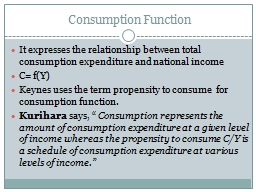

C fY Keynes uses the term propensity to consume for consumption function Kurihara says Consumption represents the amount of consumption expenditure at a given level of income whereas the propensity to consume CY is a schedule of consumption expenditure at various levels of income ID: 1028010
Download Presentation The PPT/PDF document "Consumption Function It expresses the re..." is the property of its rightful owner. Permission is granted to download and print the materials on this web site for personal, non-commercial use only, and to display it on your personal computer provided you do not modify the materials and that you retain all copyright notices contained in the materials. By downloading content from our website, you accept the terms of this agreement.
1. Consumption FunctionIt expresses the relationship between total consumption expenditure and national incomeC= f(Y)Keynes uses the term propensity to consume for consumption function.Kurihara says, “ Consumption represents the amount of consumption expenditure at a given level of income whereas the propensity to consume C/Y is a schedule of consumption expenditure at various levels of income.”
2. In words of Peterson, “ Consumption function may be defined as a schedule showing various amounts that will be spent for consumer goods and services at different levels of income.” Dillard says, “ A schedule showing the various amounts of consumption which correspond to different levels of income is the schedule of propensity to consume.”
3. ExplanationTable: Propensity to consumeIncomeConsumptionSaving010020030040050010100190280370460-10010203040ASCSXYOCSConsumption/ SavingIncome
4. Features of Propensity to ConsumePsychological ConceptUnequal Propensity to ConsumeIncome and Employment depends on propensity to consumeConsumption in short run: C=a+bYLong run consumption function: C=bY
5. Kinds of Propensity to ConsumeAverage Propensity to consume (APC)Kurihara says, “ The average propensity to consume is the ratio of consumption expenditure to any particular level of income”APC=C/YMarginal Propensity to Consume (MPC)Kurihara says, “ The marginal propensity to consume is the ratio of a change in consumption to a change in income.”MPC= Change in C Change in Y
6. Difference and relation between APC and MPCAPC is the ratio of total consumption to total income whereas MPC is the ratio of change in consumption to change in incomeIn short run, When C=a+bY, APC goes on falling but MPC remains constant with increase in income. So short run APC tends to be more than MPC.In the long run, C=bY, Both APC and MPC tend to remain constant. And APC=MPC
7. Characteristics of MPCIt is always positiveMPC lies between 0 and 1.MPC of the poor class is higherMPC remains constant in the long run.With increase in income, MPC falls in the short run.MPC can be greater than 1 in case of abnormal situations like extreme poverty.
8. Propensity to saveIt is a schedule showing relation between income and saving.Saving is a function of Income S=f(Y)Peterson says, “ Propensity to save may be defined as a schedule showing amounts that will be saved at different levels of income.” Kinds of propensity to saveAPS= S/YMPS= Change in saving/Change in Income
9. Determinant of propensity to consumeSubjective factorsFarsightednessEnlarged income in futureOccupational motiveMiserlinessStatus in societyLiquidity preferenceModernisationFinancial PrudenceObjective factorsChange in money incomeChange in real incomeWindfall gains & lossesChange in expectationsFiscal policyWagesChange in rate of interestLiquid AssetsAttraction of new products